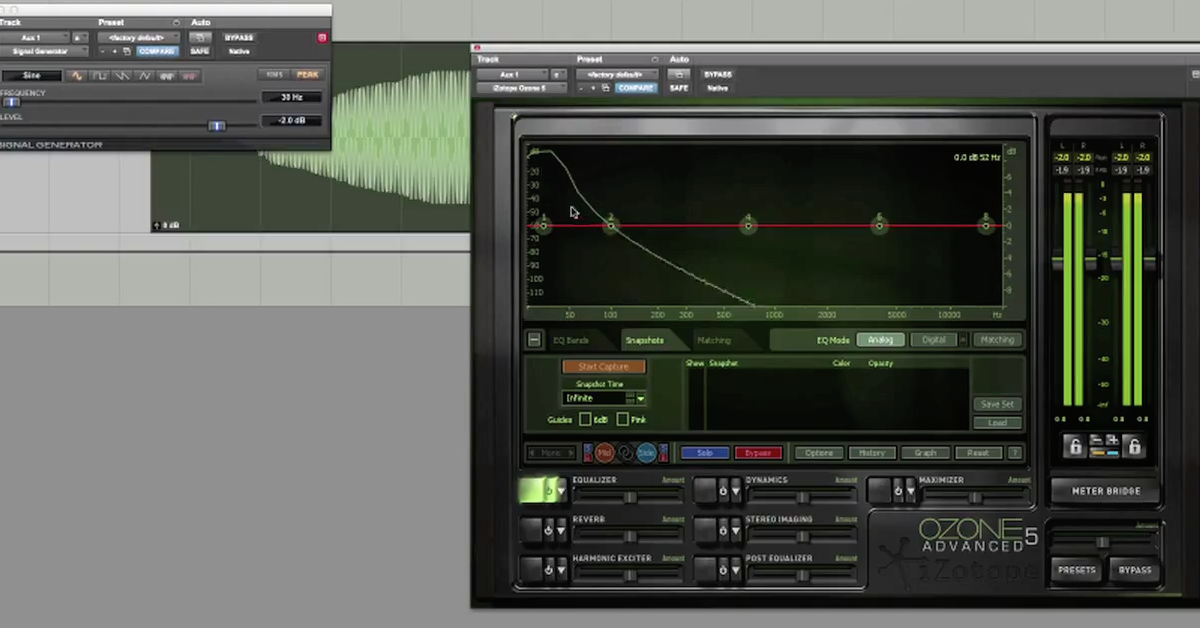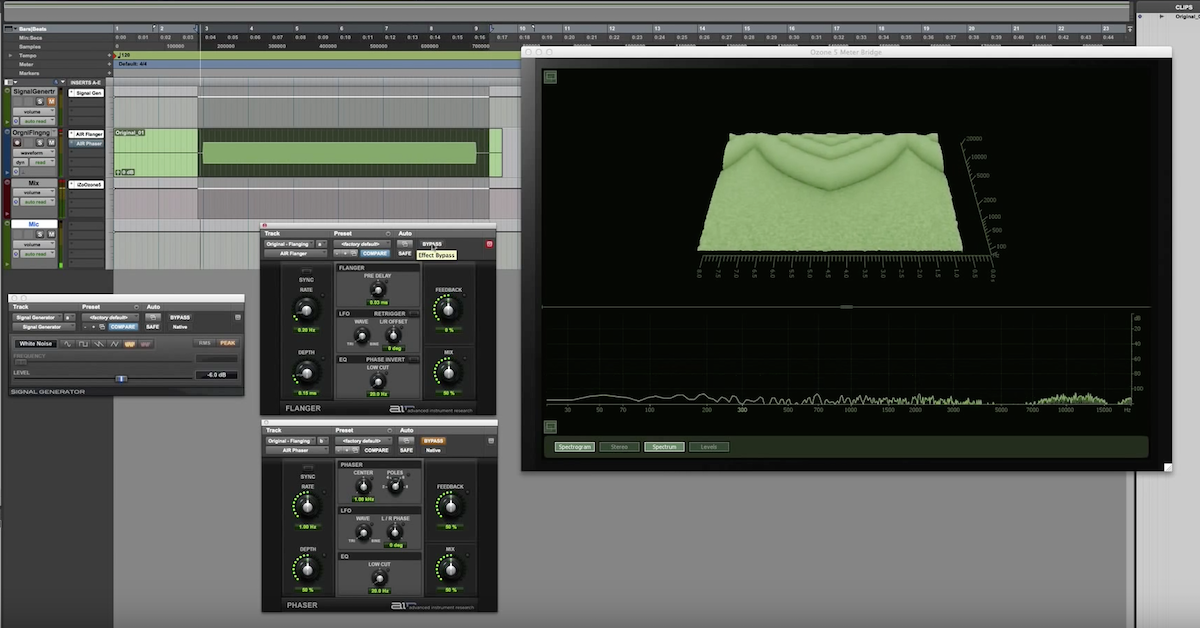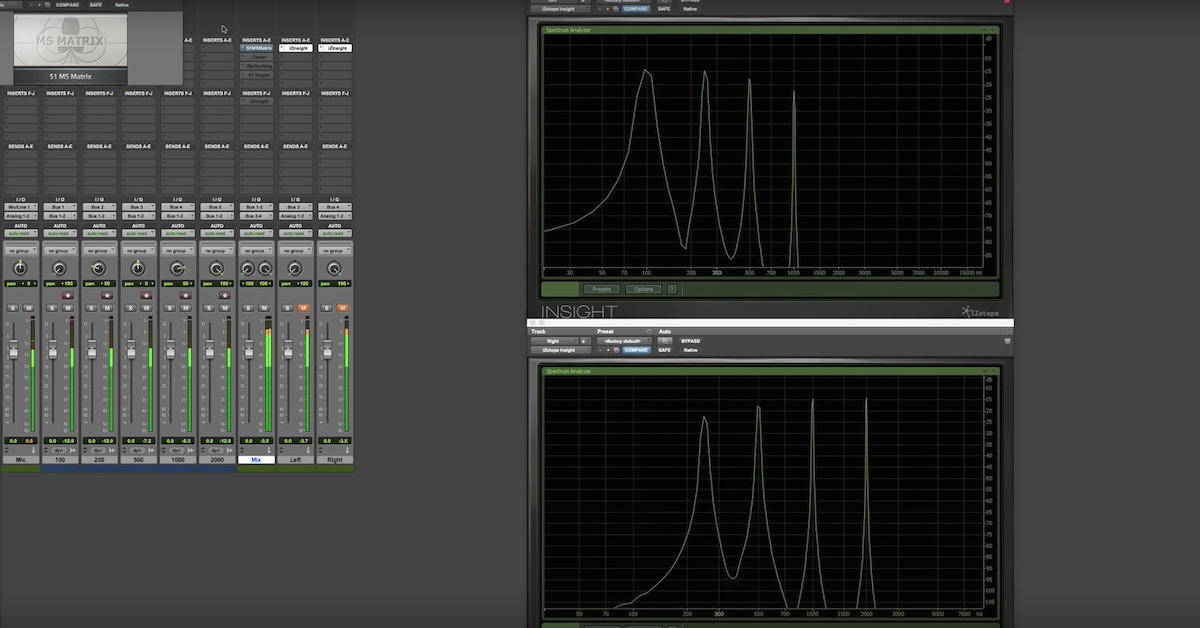The Fundamentals of AM Synthesis
Article Content
Over the last year or so I have explored some of the major synthesis techniques used in software and hardware synths in articles such as:
- The Basics of Wavetable Synthesis
- The Basics of Additive Synthesis
- Introduction to Granular Synthesis
- Introduction to FM Synthesis
- 18 Synth Parameters That Are Often Misunderstood
- 8 Tips for Building Synth Sounds from Scratch
- and more
What follows is some information on the history and fundamentals of Amplitude Modulation, which is one of the earliest forms of synthesis and signal manipulation.
History and Origins
As with Frequency Modulation (FM), Amplitude Modulation (AM) is used as a broadcasting protocol as well as in audio synthesis. It actually dates back to the “experimental and theoretical work of Leblanc, back in 1886, Mayer (1875) and Rayleigh (1894)….the first successful attempt to transmit audio signals over telephone lines took place in the mid-1870s and this has been acknowledged as one of the first transmissions taking place with the help of some form of amplitude modulation.” (History)
If you look on any AM radio dial (if they still have those) you will see that the range of available frequencies for AM radio transmission is from 535 to 1705 kHz. AM is considered a Medium Wave (MF), “which is by far the most commonly used AM broadcasting band. In ITU Regions 1 and 3, transmitting frequencies run from 531 to 1602 kHz, with 9 kHz spacing (526.5-1606.5 kHz), and in ITU Region 2 (the Americas), transmitting frequencies are 530 to 1700 kHz, using 10 kHz spacing (525-1705 kHz), including the ITU Extended AM broadcast band, authorized in Region 2, between 1605 and 1705 kHz, previously used for police radio”. (History) In contrast, Shortwave radio frequencies or High Frequency (HF) range from 2.3 to 26.1 MHz and FM broadcast frequencies range 88 to 108 MHz (in the Americas)(AM).
The FM technique uses a modulating frequency to alter the frequency of the carrier signal while AM uses a modulating frequency to alter the carrier’s amplitude. FM has a higher fidelity since it is less susceptible to interference, but AM is still widely used for voice-based broadcasts like news and sports.
The Premise
When you mix or multiply a signal’s amplitude by another signal, you are modulating the amplitude of that signal (called the Carrier) at some rate determined by the frequency of the second signal (called the Modulator). At modulating frequencies around 6 Hz, an amplitude modulated signal resembles a tremolo effect. As the frequency approaches the audio rate (20 Hz), the resulting sound takes on a sort of roughness. Above 20 Hz, we lose the ability to hear the periodic dips in amplitude and instead start to hear additional frequencies called sideband frequencies or combination tones. Two specific sideband frequencies that are produced are called Sum tones (which are the result of adding the carrier and modulator frequencies) and Difference tones (which are the result of subtracting the carrier and modulator frequencies).
Examples of Sideband Frequencies

David Creasey illustrates the basic premise underlying AM synthesis and combination tones in the following examples from his excellent book, as well as the effect of harmonically related modulator and carrier frequencies vs. inharmonic relationships. Note that in the case where a difference tone would be a negative number (such as in examples 20.4c and 20.4d below), the resulting difference tone gets wrapped around back to the positive. So a difference tone of -500Hz, become 500Hz. (Creasey 562)
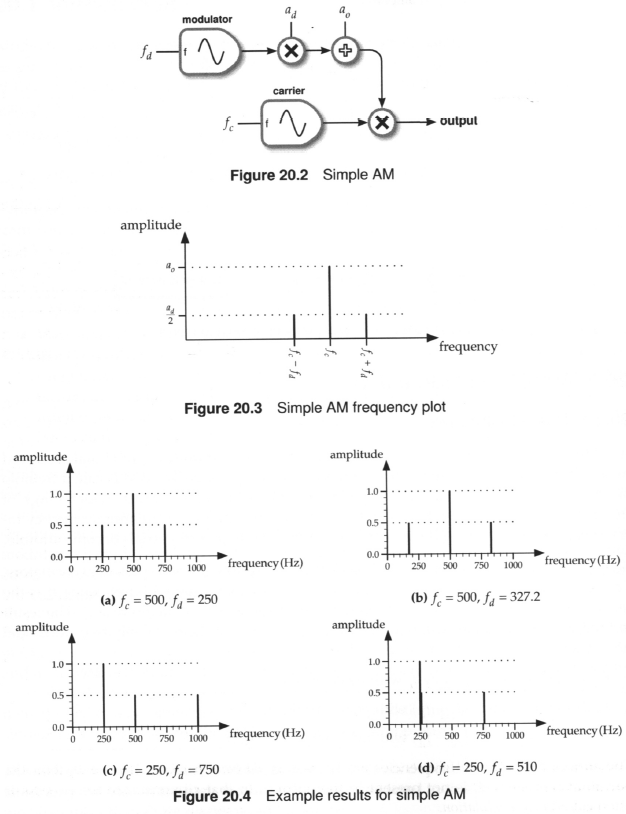
Looking at the idea of combination tones in terms of traditional notation might look something like the figure below. Here the Carrier frequency would be A = 220Hz. The Modulator frequencies are listed on the top staff and the resulting combination tones on the bottom staff.
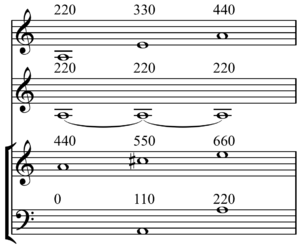
Audio Applications
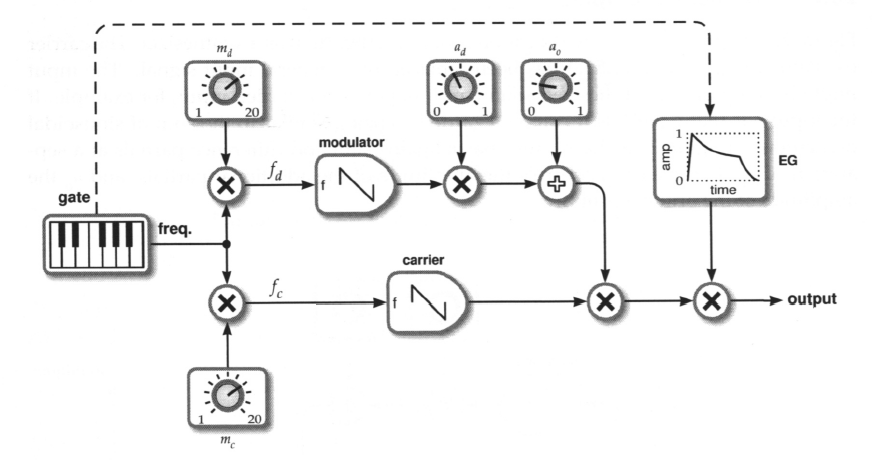
The figure above (Creasey 566) shows a block diagram of an AM Synthesizer. Note that although the process is relatively simple, when you introduce various combinations of waveforms for the carrier and modulator signals, including an amplitude envelope at the end of signal path and other modulators (LFOs, multi-stage envelopes, etc.) that are set up to modulate the modulators, things can get complex and interesting relatively quickly. As more frequencies and the harmonics of these frequencies are introduced, they also interact and create even more combination tones.
RM vs AM
Ring Modulation (RM) is a simple form of Amplitude Modulation (AM) in which the amplitude is allowed to dip down to zero, as opposed to other methods of AM which include a DC Offset that acts like a depth or intensity control. The figure below shows the difference between the two methods given the same Modulation and Carrier frequencies:
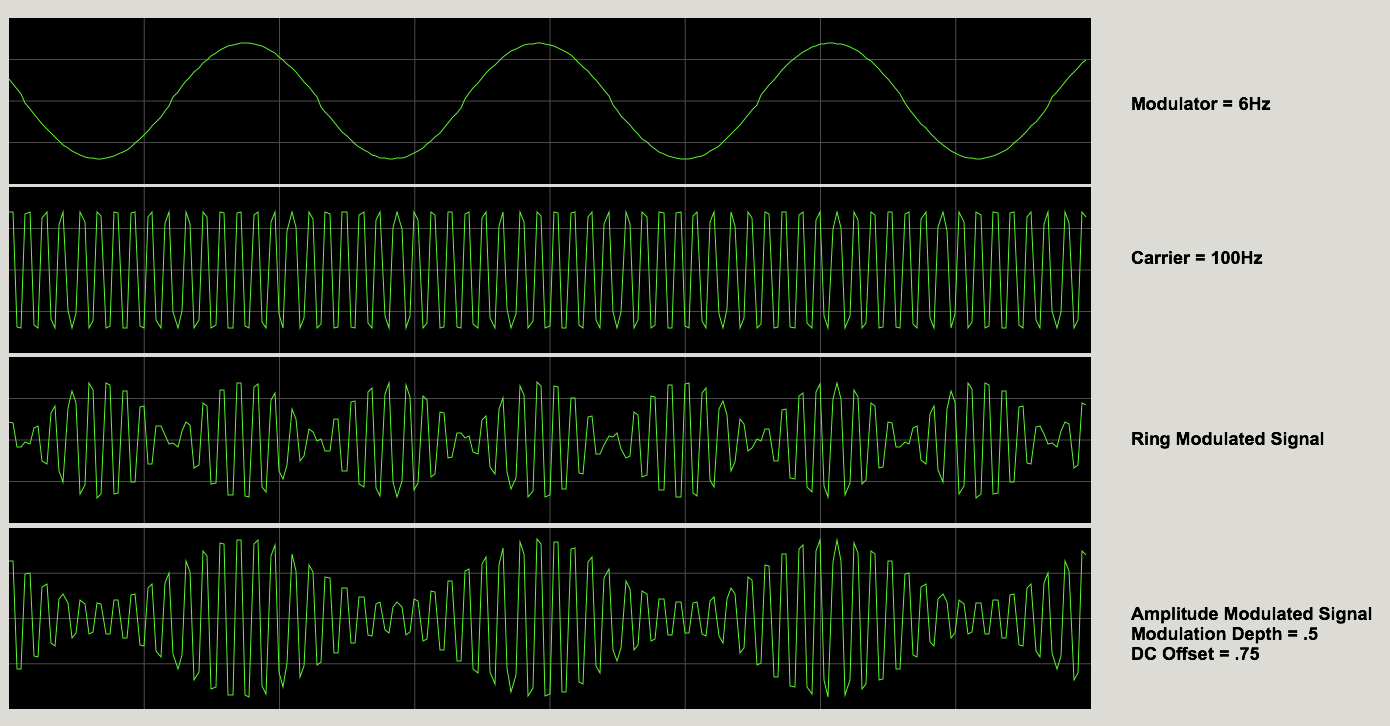
Note that in this scenario, the Ring Modulation rate (which would be perceived as a tremolo) causes the amplitude to dip two times per cycle, which creates a tremolo effect that is twice the rate of the AM method using the same carrier and modulation frequencies. In other words, AM creates a unipolar wave that never goes below zero, whereas Ring Modulation produces a bipolar wave.
Applications
You probably won’t find anything that calls itself a dedicated AM Synthesizer as you might find in an FM Synthesizer. Many of the synths you already have probably use Amplitude and/or Ring Modulation in one form or the other. In the simplest case, you just need two oscillators, a carrier and a modulator.
You can accomplish AM synthesis or Ring Modulation with a handful of Eurorack modules. Soft synths make routing modulation sources and targets a relatively painless process and the possibilities can seem limitless and daunting. So the more you know about how oscillators can interact and the potential sonic results, the faster you can get to that sound in your head you’ve been after. Knowing what will happen before you move a slider, turn a knob or make a connection is essential to getting results quickly. That said, trial and error and randomizing processes will always have a place when you have the time to experiment.
Conclusion
As Gordon Reid observes, “Amplitude Modulation is a powerful tool that allows you to create and play new sounds that you cannot obtain using conventional oscillators alone”. (Reid)
For a more in-depth discussion of Amplitude Modulation in the Audio realm, I highly recommend the sources I’ve quoted in this article and listed below. For more information on synthesis in general, check out my articles, interviews, software reviews and video tutorial series Synthesis 101, available exclusively on The Pro Audio Files.
Notes and Sources
“AM Broadcasting.” Wikipedia, Wikimedia Foundation, 29 June 2018, en.wikipedia.org/wiki/AM_broadcasting#VHF_AM_broadcasting.
Creasey, D. J. Audio Processes: Musical Analysis, Modification, Synthesis, and Control. Routledge, 2017.
Reid, Gordon. “Amplitude Modulation.” Soundonsound.com, Sound on Sound, 1 Mar. 2000, www.soundonsound.com/techniques/amplitude-modulation.
Roads, Curtis. The Computer Music Tutorial. MIT Press, 2012.
Russ, Martin. Sound Synthesis and Sampling. Focal Press, 2013.
“The History of Amplitude Modulation.” Brighthub Engineering, 30 Oct. 2011, www.brighthubengineering.com/consumer-appliances-electronics/126317-the-engineering-history-of-am-radio/.
Check out my other articles, reviews and interviews
Follow me on Twitter / Instagram / YouTube



